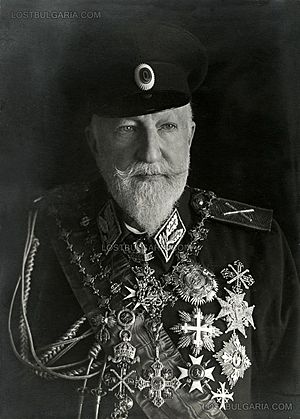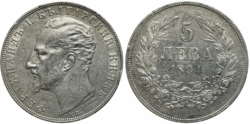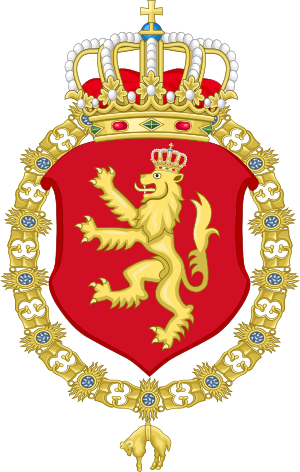Ferdinand I of Bulgaria facts for kids
Quick facts for kids Ferdinand |
|||||
|---|---|---|---|---|---|
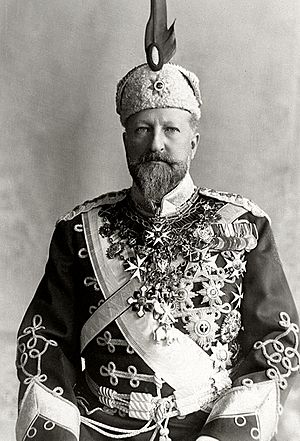
Ferdinand in 1912
|
|||||
| Tsar of Bulgaria | |||||
| Reign | 5 October 1908 – 3 October 1918 | ||||
| Predecessor | Himself as Prince | ||||
| Successor | Boris III | ||||
| Prince of Bulgaria | |||||
| Reign | 7 July 1887 – 5 October 1908 | ||||
| Predecessor | Alexander | ||||
| Successor | Himself as Tsar | ||||
| Born | 26 February 1861 Vienna, Austrian Empire |
||||
| Died | 10 September 1948 (aged 87) Coburg, Allied-occupied Germany |
||||
| Burial | St. Augustin, Coburg | ||||
| Spouse |
|
||||
| Issue |
|
||||
|
|||||
| House | Saxe-Coburg and Gotha-Koháry | ||||
| Father | Prince August of Saxe-Coburg and Gotha | ||||
| Mother | Princess Clémentine of Orléans | ||||
| Religion | Roman Catholic | ||||
| Signature |  |
||||
Ferdinand I (born Ferdinand Maximilian Karl Leopold Maria of Saxe-Coburg and Gotha; 26 February 1861 – 10 September 1948) was an important ruler of Bulgaria. He first became the ruling prince (knyaz) in 1887. Later, in 1908, he became the king (tsar) of Bulgaria.
Ferdinand led Bulgaria during a time of big changes in Europe. He was the second monarch of the Third Bulgarian State. Under his rule, Bulgaria joined the Central Powers in World War I in 1915. He gave up his throne in 1918.
Contents
Ferdinand's Family and Early Life
Ferdinand was born on 26 February 1861 in Vienna, which was then part of the Austrian Empire. He was a German prince from the House of Saxe-Coburg and Gotha-Koháry. His father was Prince August of Saxe-Coburg and Gotha. His mother was Clémentine of Orléans, who was the daughter of King Louis Philippe I of the French.
Ferdinand grew up in a rich and important family. Many of his relatives were kings and queens in Europe. For example, he was a grandnephew of Queen Victoria of the United Kingdom and Leopold I of Belgium. This meant he had family connections to many royal houses across Europe.
Becoming Prince of Bulgaria

Before Ferdinand, the ruler of Bulgaria was Alexander of Battenberg. He had to step down in 1886 after a political event. Bulgaria needed a new leader. Many princes were offered the job, but they all said no.
Ferdinand, who was an officer in the Austro-Hungarian army, was chosen as the Prince of Bulgaria on 7 July 1887. Some European royals were surprised by this choice. Queen Victoria even thought he was "totally unfit." But Ferdinand proved them wrong and did a good job for the first 20 years of his rule.
In his early years as prince, a powerful politician named Stefan Stambolov had a lot of influence. Stambolov's foreign policy made relations with Russia cooler. Russia had previously been seen as Bulgaria's protector.
After Stambolov's influence ended in 1894, Bulgaria's relationship with Russia improved. In 1896, Ferdinand decided to change his young son, Prince Boris, from Roman Catholic to Eastern Orthodox Christian. This decision made his Catholic relatives in Austria unhappy. He was even removed from the Catholic Church by Pope Leo XIII.
Becoming Tsar of Bulgaria
On 5 October 1908, Ferdinand declared Bulgaria completely independent from the Ottoman Empire. Before this, Bulgaria had been mostly independent since 1878, but this made it official. He also announced that Bulgaria was now a kingdom.
Ferdinand took the title of tsar. This title was used by rulers of earlier Bulgarian kingdoms. While tsar meant "emperor" in the past, under Ferdinand and his successors, it was translated as "king." This important declaration happened at the Holy Forty Martyrs Church in Veliko Tarnovo. Other European countries and the Ottoman Empire recognized Bulgaria's new status.
Ferdinand was known for his interesting personality. Once, during a visit to German Emperor Wilhelm II in 1909, the Emperor playfully slapped Ferdinand. Ferdinand was offended and got his revenge. He decided to give a big weapons contract to a French company instead of a German one.
Another time, on his way to a funeral in 1910, there was an argument about where his train car would be. The heir to the Austro-Hungarian throne, Archduke Franz Ferdinand of Austria, got his car placed right behind the engine. Ferdinand's car was next. Since the dining car was behind Ferdinand's, he refused to let the Archduke walk through his car to get to dinner. Ferdinand also made history on 15 July 1910, when he became the first head of state to fly in an airplane. He even gave the pilot a medal!
Balkan Wars (1912-1913)
Ferdinand dreamed of making Bulgaria a powerful Christian nation in the Balkan Peninsula. In 1912, Bulgaria joined other Balkan countries to fight against the Ottoman Empire. They wanted to free lands that were still under Ottoman rule. Ferdinand called this war "a just, great and sacred struggle."
Bulgaria fought hard and lost many soldiers in this war. The major European powers then decided that Albania should be an independent country. This caused problems among the Balkan allies. In the First Balkan War, Serbia had promised to give most of Vardar Macedonia to Bulgaria. But because Albania gained land, Serbia decided to keep the areas its forces had taken.
Soon after, Bulgaria started the Second Balkan War by attacking its former allies, Serbia and Greece. Then, Romania and the Ottoman Empire also attacked Bulgaria. Bulgaria was defeated, but the Treaty of Bucharest in 1913 still gave Bulgaria some new land. This included Western Thrace, which gave Bulgaria access to the Aegean Sea.
World War I and Abdication (1915-1918)
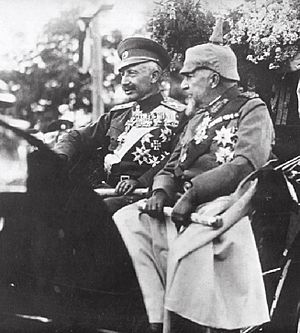
On 11 October 1915, Bulgaria joined World War I. Ferdinand signed a treaty with Austria-Hungary and Germany. Bulgaria attacked Serbia, hoping to gain more land. Even though Ferdinand wasn't a big fan of the German or Austrian emperors, he wanted to expand Bulgaria's territory after the Balkan Wars. This also meant forming an alliance with the Ottoman Empire, which had been Bulgaria's enemy.
In the early part of World War I, the Bulgarian army won some important battles. They took control of disputed areas in Macedonia after Serbia was defeated. For the next two years, the Bulgarian army focused on stopping attacks from the Allies coming from nearby Greece. They also helped in the 1916 conquest of Romania.
By 1918, Bulgaria faced many military problems. To save the Bulgarian monarchy, Tsar Ferdinand decided to step down. He gave up his throne to his oldest son, who became Tsar Boris III on 3 October 1918. After Ferdinand's abdication, Bulgaria surrendered to the Allies. As a result, Bulgaria lost the new lands it had gained in the war, and also the land that gave it access to the Aegean Sea.
Ferdinand's Later Life and Death
After giving up his throne, Ferdinand moved back to Coburg, Germany. He had saved a lot of his money and lived comfortably. He saw being in exile as a normal part of being a king. He believed that kings were taught to be strong and not show their feelings, even when things were tough. He was happy that his son could take over the throne.
Ferdinand enjoyed his exile. He spent his time on art, gardening, traveling, and studying nature. However, he lived to see many sad events. His oldest son, Tsar Boris III, died in 1943 after visiting Adolf Hitler in Germany. Boris's son, Simeon II, became king but was removed from power in 1946. This ended the Bulgarian monarchy.
Bulgaria then became a communist country. Ferdinand's other son, Kyril, passed away under difficult circumstances during this time. When Ferdinand heard about Kyril's death, he said, "Everything is collapsing around me."
In 1947, Ferdinand, who was 86 years old, married his 26-year-old assistant, Alžbeta Brezáková, in secret. His family was not happy about this marriage. After Ferdinand died, she returned to her home country, Czechoslovakia. She later remarried and had a daughter. She kept her marriage to Ferdinand a secret from her daughter until two years before her own death in 2015.
Ferdinand died on 10 September 1948 in Coburg, Germany. He was the last surviving grandchild of Louis Philippe I of the French. His last wish was to be buried in Bulgaria. However, the communist government in Bulgaria did not allow it. So, he was buried in his family's crypt in St. Augustin, Coburg.
Honours
| Styles of King Ferdinand I of Bulgaria |
|
|---|---|
| Reference style | His Majesty |
| Spoken style | Your Majesty |
Bulgarian Honours
- Grand Cross of St. Alexander, in Diamonds, 27 May 1883
- Founder and Grand Master of the Civil Merit Order, 1891
- Founder and Grand Master of the Military Merit Order, 19 May 1900
- Founder and Grand Master of the Order of Saints Cyril and Methodius, 18 May 1909
Foreign Honours
 Albanian Royal Family:
Albanian Royal Family:
- Knight of the Order of Albania, with Collar
- Grand Cross of the Order of Fidelity, Special Class

 Austro-Hungarian Imperial and Royal Family:
Austro-Hungarian Imperial and Royal Family:
- Grand Cross of the Royal Hungarian Order of St. Stephen, with Collar, 1899; in Diamonds, 1917
- Knight of the Golden Fleece, with Collar, 1911
- Military Merit Cross, 3rd Class with War Decoration, 1915
- Grand Cross of the Military Order of Maria Theresa, with Collar, 1917
 Bavarian Royal Family:
Bavarian Royal Family:
- Knight of St. Hubert, 1896
- Grand Cross of the Military Order of Max Joseph
 Belgium: Grand Cordon of the Order of Leopold
Belgium: Grand Cordon of the Order of Leopold Brazilian Imperial Family: Grand Cross of the Rose, with Collar
Brazilian Imperial Family: Grand Cross of the Rose, with Collar Denmark: Knight of the Elephant, with Collar, 20 May 1910
Denmark: Knight of the Elephant, with Collar, 20 May 1910

 Ernestine Ducal Families:
Ernestine Ducal Families:
- Grand Cross of the Saxe-Ernestine House Order, 1879
- Knight of the Order of Saint Joachim, 1888
 France: Grand Officer of the Legion of Honour, 1905
France: Grand Officer of the Legion of Honour, 1905
 French Royal Family:
French Royal Family:
- Knight of St. Michael
- Grand Cross of St. Lazarus, with Collar
 Hessian Grand Ducal Family: Grand Cross of the Ludwig Order, 28 November 1893
Hessian Grand Ducal Family: Grand Cross of the Ludwig Order, 28 November 1893 Italian Royal Family:
Italian Royal Family:
- Knight of the Annunciation, with Collar, 10 July 1897
- Grand Cross of Saints Maurice and Lazarus
- Grand Cross of the Crown of Italy
 Parmese Ducal Family: Senator Grand Cross of the Constantinian Order of St. George, 1893
Parmese Ducal Family: Senator Grand Cross of the Constantinian Order of St. George, 1893 Two Sicilian Royal Family: Knight of St. Januarius
Two Sicilian Royal Family: Knight of St. Januarius
 Sovereign Military Order of Malta: Bailiff Grand Cross of Justice, 1st Class
Sovereign Military Order of Malta: Bailiff Grand Cross of Justice, 1st Class Monaco: Grand Cross of St. Charles, 11 May 1892
Monaco: Grand Cross of St. Charles, 11 May 1892 Portuguese Royal Family:
Portuguese Royal Family:
- Grand Cross of the Sash of the Two Orders, 17 July 1886
- Grand Cross of the Tower and Sword, 17 July 1886
 Prussian Royal Family:
Prussian Royal Family:
- Grand Cross of the Red Eagle, with Collar, 2 May 1896
- Knight of the Black Eagle, with Collar
- Iron Cross (1914), 2nd and 1st Classes
- Pour le Mérite (military), with Oak Leaves, 8 September 1916
 Romanian Royal Family: Collar of the Order of Carol I
Romanian Royal Family: Collar of the Order of Carol I Russian Imperial Family:
Russian Imperial Family:
- Knight of St. Andrew, with Collar, 1907
- Knight of St. Alexander Nevsky, 10 February 1910
- Knight of the White Eagle
- Knight of St. Anna, 1st Class
- Knight of St. Vladimir, 1st Class
 Spanish Royal Family: Grand Commander of the Order of Calatrava
Spanish Royal Family: Grand Commander of the Order of Calatrava Sweden: Knight of the Seraphim, with Collar, 28 June 1937
Sweden: Knight of the Seraphim, with Collar, 28 June 1937 Turkish Imperial Family:
Turkish Imperial Family:
- Order of Distinction in Diamonds, 26 March 1896
- Exalted Order of Honour, 1915
 United Kingdom:
United Kingdom:
- Queen Victoria Diamond Jubilee Medal, 1897
- Honorary Grand Cross of the Royal Victorian Order, 6 September 1904
- Honorary Grand Cross of the Bath (civil), 7 March 1905
 Württemberg Royal Family: Grand Cross of the Military Merit Order
Württemberg Royal Family: Grand Cross of the Military Merit Order
Honorary Military Appointments
 Russian Empire: Colonel of the 54th Minsk Regiment, 1902
Russian Empire: Colonel of the 54th Minsk Regiment, 1902
See also
 In Spanish: Fernando I de Bulgaria para niños
In Spanish: Fernando I de Bulgaria para niños
- Order of Saints Cyril and Methodius
Books
- Aronson, Theo (1986). Crowns In Conflict: The Triumph And The Tragedy Of European Monarchy, 1910–1918. London: J.Murray. ISBN 0-7195-4279-0.
- Constant, Stephen (1986). Foxy Ferdinand, 1861–1948, Tsar of Bulgaria. London: Sidgwick and Jackson. ISBN 0-283-98515-1.
- Louda, Jiri; Michael Maclagan (1981). Lines of Succession. London: Orbis Publishing Ltd. ISBN 0-460-04519-9.
- Massie, Robert K (1981). The Last Courts of Europe. London: J.M.Dent & Sons Ltd. ISBN 0-460-04519-9.
- Palmer, Alan (1978). The Kaiser: Warlord Of The Second Reich. London: Weidenfeld and Nicolson. ISBN 0-297-77393-3.


